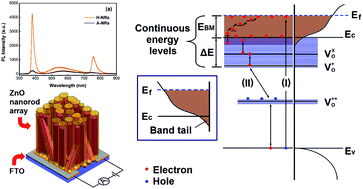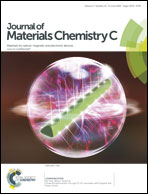Selectively enhanced UV and NIR photoluminescence from a degenerate ZnO nanorod array film
Abstract
Energy band engineering is a promising method to tune the photoelectric properties of semiconductors. In this paper, we report an un-element-doped ZnO nanorod array film with a degenerate energy band via annealing in a hydrogen atmosphere. Due to the energy band modification, the photogenerated carrier transitions in the degenerate energy band, involving the valance band, the defect bands and the degenerate conduction band, cause unique photoelectric properties in the degenerate ZnO film. The degenerate ZnO film performs with outstanding conductivity and exhibits an obvious optical absorption in the visible region. Its photoluminescence and photoresponse properties are investigated to understand the fundamentals of photogenerated carrier excitation and recombination in the degenerate ZnO film. Interestingly, the degenerate ZnO film performs with poor photoresponse and has poor photocurrent efficiencies for ultraviolet, blue, and green illuminations, but the photoresponse for near-infrared illumination is attractive. Our results also demonstrate the selectively enhanced down-conversion photoluminescence both at the UV band and at the near-infrared band from the degenerate ZnO film after being excited by an ultraviolet laser source.


 Please wait while we load your content...
Please wait while we load your content...